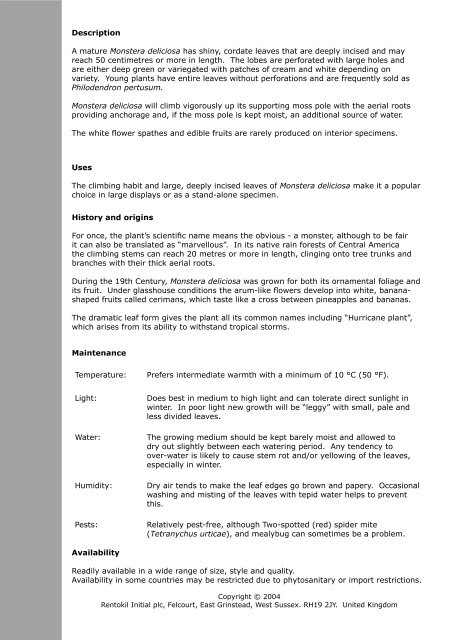Monstera deliciosa - Plants In Buildings
Monstera deliciosa - Plants In Buildings
Monstera deliciosa - Plants In Buildings
Create successful ePaper yourself
Turn your PDF publications into a flip-book with our unique Google optimized e-Paper software.
Description<br />
A mature <strong>Monstera</strong> <strong>deliciosa</strong> has shiny, cordate leaves that are deeply incised and may<br />
reach 50 centimetres or more in length. The lobes are perforated with large holes and<br />
are either deep green or variegated with patches of cream and white depending on<br />
variety. Young plants have entire leaves without perforations and are frequently sold as<br />
Philodendron pertusum.<br />
<strong>Monstera</strong> <strong>deliciosa</strong> will climb vigorously up its supporting moss pole with the aerial roots<br />
providing anchorage and, if the moss pole is kept moist, an additional source of water.<br />
The white flower spathes and edible fruits are rarely produced on interior specimens.<br />
Uses<br />
The climbing habit and large, deeply incised leaves of <strong>Monstera</strong> <strong>deliciosa</strong> make it a popular<br />
choice in large displays or as a stand-alone specimen.<br />
History and origins<br />
For once, the plant’s scientific name means the obvious - a monster, although to be fair<br />
it can also be translated as “marvellous”. <strong>In</strong> its native rain forests of Central America<br />
the climbing stems can reach 20 metres or more in length, clinging onto tree trunks and<br />
branches with their thick aerial roots.<br />
During the 19th Century, <strong>Monstera</strong> <strong>deliciosa</strong> was grown for both its ornamental foliage and<br />
its fruit. Under glasshouse conditions the arum-like flowers develop into white, bananashaped<br />
fruits called cerimans, which taste like a cross between pineapples and bananas.<br />
The dramatic leaf form gives the plant all its common names including “Hurricane plant”,<br />
which arises from its ability to withstand tropical storms.<br />
Maintenance<br />
Temperature: Prefers intermediate warmth with a minimum of 10 °C (50 °F).<br />
Light: Does best in medium to high light and can tolerate direct sunlight in<br />
winter. <strong>In</strong> poor light new growth will be “leggy” with small, pale and<br />
less divided leaves.<br />
Water: The growing medium should be kept barely moist and allowed to<br />
dry out slightly between each watering period. Any tendency to<br />
over-water is likely to cause stem rot and/or yellowing of the leaves,<br />
especially in winter.<br />
Humidity: Dry air tends to make the leaf edges go brown and papery. Occasional<br />
washing and misting of the leaves with tepid water helps to prevent<br />
this.<br />
Pests: Relatively pest-free, although Two-spotted (red) spider mite<br />
(Tetranychus urticae), and mealybug can sometimes be a problem.<br />
Availability<br />
Readily available in a wide range of size, style and quality.<br />
Availability in some countries may be restricted due to phytosanitary or import restrictions.<br />
Copyright © 2004<br />
Rentokil <strong>In</strong>itial plc, Felcourt, East Grinstead, West Sussex. RH19 2JY. United Kingdom


